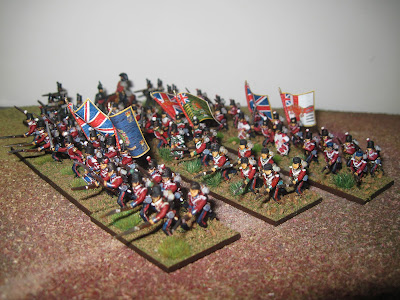Above, the Foot Guards. Currently two battalions and all from Minifigs. I have a third to finish from Irregular. On their first outing the Foot Guards did not do well. So much so that Colin Campbell opined it would have been better if they had all been shot rather than run away. Luckily for them Campbell was ignored. All the same we can note that they subsequently performed no better than the British Line Regiments.
We also see the Duke of Cambridge condescending to his pals. The (Irregular) British Rifles are clearing the way. Temple Godman heard the Duke lost the run of himself after the Alma and then heard he hadn't. Now we would call it PTSD.
I first read about the Crimean War decades ago. Hibbert, Cecil Woodham-Smith all interesting stuff. I like to paint and the uniforms were splendid. Yet, I didn't make the jump. I saw both films. Enjoyed them too. No change.
It was painting above that tipped the balance. I thought I want to do that in 15mm.
Brigaded with the Guards at the Alma were the Highlanders. Commanded by Colin Campbell. He handled them well throughout. It is timely for us to consider Captain Godman's account of the "Thin Red Streak" incident immortalised by WH Russell. Godman observed the whole thing, as ever he repays our attention.
My first British Line Brigade. I used Maverick Flags for my British Line Battalions. Well worth a look and an excellent service. First two battalions are Minifigs, the third Irregular.
The French who had a "good" Crimean War were impressed by their British comrades. The latter were responded in the same fashion. Both finding qualities to admire in the other. This seems true at every level of rank.
Raglan might have been an exception. On occasions he referred to the Russians as the French. He also defaulted on a previously agreed French battle plan at the Alma. Even so, it might be reading to much into those things to exclude him from what was obviously a cordial relationship.
The British infantry mostly fought well in the Crimea. The failure to press home at Sevastopol was that of exhausted and demoralised men. Simply put they had had enough.
I'm rating them as Trained through out, same with the Russians. The French might get a Trained Elite. Wedded as they were to the offensive. They wont fight any better but they will keep coming.
The British rank and file were quick to appreciate the value of the Minié. Given their heads they would stand off and shoot. The higher ranks pretty much ignored it as a harbinger of tactical change. Partly this was their age and a reluctance to change the methods they knew. They had worked well enough for Wellington.
Even Campbell, a diligent Brigadier, made absolutely no adjustment to his tactics in the Crimea or subsequently. Volley, and charge or volley, volley and charge as a rule.
My second British Line Brigade. All Minifigs this time. Old they might be but I like them a great deal. There are three poses of line infantry figures there should variety be an issue. The command figures are first rate.
The War was hard on the troops, not just the fighting. Cold, hunger and disease all took there toll on officers and men alike. The wealthier officers might recuperate on a friends yacht or even their own. Most though relied on whatever comfort there was to be had in the lines. Scant as it was.
Captain Godman closely tracked the officers who put in their papers. Lots did. It was the age of purchase after all. He was keenly aware that it might have implications for him. A duffer might get command or an opportunity might appear.
By the time of the assault on Sevastopol the British soldiers were worn out. When the war ended in an allied victory the original British Army was effectively gone. Some of the replacements who had arrived were 15 years of age and terrified. Who could blame them?






.jpg)

























